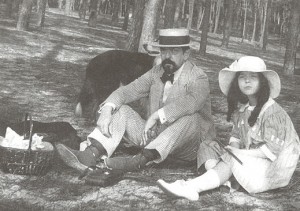
New World Examines Debussy (With a Movie, Too)
Even though we’ve passed the halfway mark of April, classical events are still thick on the ground.
This Saturday, Florida Grand Opera opens its production of Carmen, and on Sunday, the Palm Beach Opera holds its 41st annual Vocal Competition Grand Finals Concert, in which 12 finalists will compete for about $78,000 in prize money.
Also, the men of the Seraphic Fire ensemble this week perform a candlelight concert of music from the Gregorian chant tradition, as well as Renaissance motets, starting Thursday in Key Biscayne and ending Sunday in Miami Beach. There’s “mystical” choral music Sunday from the University of Miami Frost Chorale at St. Philip’s in Coral Gables, and a three-day festival starting Friday at Barry University that will end with a performance Sunday of the Misa Azteca of the California-born film composer Joseph Julian Gonzalez.
And over at the New World Symphony, starting this weekend and ending May 1, it’s a week of concerts and multimedia events focusing on Claude Debussy. The great French composer’s legacy is remarkable from the standpoint of creating a new sound world for music in a career that was cut short by rectal cancer in 1918, when Debussy was only 55.
Since Debussy is a relatively modern figure by that measure, the full measure of his impact on music has not yet been taken, it seems to me. Although few musicians question his eminence, it’s interesting how rarely his music gets played in the concerts I’ve been to over the past few years.
I heard pianist Richard Goode do some revelatory work with a few of the Preludes three or four years ago, and this season has been notable for several readings of the very early Piano Trio in G major, which I think is a lovely work, very accomplished and thoroughly charming even though it’s not an example of the composer’s mature style.
But while I have heard the Prelude to the Afternoon of a Faun reasonably regularly, I can’t recall the last time I heard live readings of La Mer, for instance, or Jeux, so I’m excited to see that the last-named is set for April 30 on a program with the rarely heard Fantasy for piano and orchestra, and that La Mer will be played May 1 on a concert with the Prelude.
A real treat comes Sunday with a Debussy chamber music concert that will include all three of his late sonatas, all he was able to finish of a set of six. These are all splendid pieces in different ways, but my favorite remains the Violin Sonata, which I consider a masterpiece several times over. One of my fondest memories of music school is working with my violinist roommate on this work (I played piano) in an intense lesson or two with Rafael Druian, who had been concertmaster of the Cleveland Orchestra and New York Philharmonic.
Druian (who died in 2002) told us things about Debussy’s style that have stayed with me, especially that the rhythm and pulse of the composer’s music, despite its shape-shifting sound, must be precise in order for the music to work correctly. Once he pointed that out, the sonata started to make more sense and for me, it became a permanent favorite.
One other fun thing New World is doing is showing Ken Russell’s 1965 TV movie, The Debussy Film, on Wednesday night. Thanks to the invaluable army of enthusiasts out there on YouTube, excerpts are available, such as this one (it gets a tad racy at the end) of the great Oliver Reed as Debussy at a swinging party where everyone’s dancing to the Kinks, and he wants to hear the Danse profane. Annette Robertson is the actress confronting him, apparently playing Gaby Dupont, Debussy’s paramour from 1889 to 1898.
It’s a hoot, and somehow it makes sense for a film about Debussy.